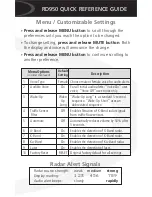
7
LINCE ITALIA S.p.A.
Fig. 10
Fig. 9
5.3 FISSAGGIO DEL RILEVATORE
•
Cablare, secondo le proprie necessità il trasmettitore
(consultare il relativo manuale istruzioni),
•
inserirlo e fissarlo all’interno dell’apposito vano presente nel
contenitore stagno,
•
inserire la guarnizione o-ring (
P
) nella sede presente sul
supporto elettronica (
D
),
•
accoppiare il rilevatore con il fondo stagno quindi avvitare le
sette viti metriche in dotazione (rif.
N
, v. fig. 4).
NB: evitare di allungare la guarnizione all’atto dell’inseri-
mento.
5.4 CHIUSURA DEL RILEVATORE
•
Dopo aver effettuato le regolazioni meccaniche del PIR
inferiore e della sensibilità dei PIR, chiudere il rilevatore
applicando il coperchio con lente di Fresnel dall’alto verso il
basso come in figura.
•
Fissare avvitando la vite metrica in acciaio inox (rif.
H
, v. fig.
4).
6 CABLAGGIO
Non può essere definito un cablaggio univoco in quanto, per
rendere il rilevatore universale è stato lasciato all’installatore
il compito di collegare i cavi in base alle necessità e alle
caratteristiche del trasmettitore utilizzato.
5.3 FIXING DETECTOR
•
Wiring as needed the transmitter (see its instruction manual),
•
insert the transmitter into the hermetic casing,
•
insert the o-ring gasket (
P
) into its seat located on the
electronic holder (
D
),
•
couple the detector and the hermetic casing then screw the
seven screws (ref.
N
, see fig. 4).
Note: Pay attention to not stretch out the o-ring gasket du-
ring its installation.
5.4 CLOSING DETECTOR
•
After wiring and range setting lower PIR position adjustment
and PIRs sensitivity, close the detector with the front cover
with Fresnel lens.
•
Hook it up to the electronic holder side ant screw up the
metric screw (ref.
H
, see fig. 4).
6 WIRING
There is not a unique wiring type, it depends on the pin out of the
transmitter intended to be connected.
The detector is provided of a six wires cable to be used to make
the electrical connections.






























